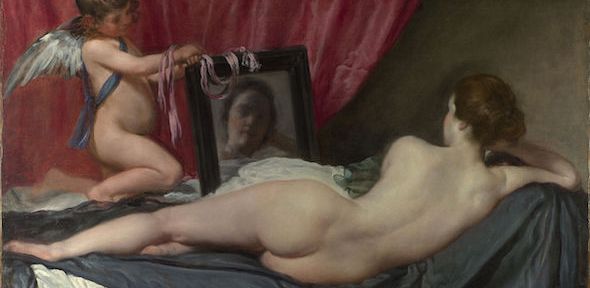Diego Velázquez, Venus del espejo (ca.1647-1651)
This paper is available for the academic year 2023-24.
Velázquez’s Venus invites the viewer to look into the mirror in order to solve her riddles. The tensions of the image are those of its time —the early modern period ushered in an innovative poetic language with ancient roots, the possibility of redemption or perdition through a New World, and a dramatic and visual culture that stimulates the imagination of the spectator. This paper covers the period known as Hispanic Golden Age (16th and 17th centuries), a moment of cultural change and imperial expansion, of political contrasts and paradoxes. The ‘discovery’ and invasion of America, the Reformation, the rise of philosophical skepticism and the spread of Copernicus’ heliocentric theses changed dramatically the way in which the world was understood. This is clearly reflected and interrogated in literature and the arts, with the development of the Renaissance and then of the Baroque, leading to some of the most revolutionary early modern works, ranging from the surreal burlesque poetry of Quevedo and Caviedes, the cynical and parodic picaresque novel, the first European descriptions of the New World by Christopher Columbus and Gonzalo Fernández de Oviedo, collaborative pictographic accounts of the Aztecs made by indigenous artists and Spanish friars, Cervantes’s hybrid and ‘postmodern’ Don Quijote, Góngora’s challenging Soledades, imitated by Sor Juana in her Primero sueño, the irreverent plays of Lope, Tirso and Calderón, the mestizo historiography of the Inca Garcilaso de la Vega and the multilayered approach to the representation of reality in the paintings of Velázquez and Valdés Leal. By exploring the works of these artists and thinkers we will engage with ideas and questions that, centuries later, are still our own. And, perhaps, we will be able to decipher the mystery that lies beyond Venus’s enigmatic gaze.
The content and the material taught will be organized in 3 sections. The first cluster of sections A and B will serve as a historical and theoretical introduction to each section.
SECTION A. Knowledge and Empire
Imperial Expansion as Knowledge
First Encounters
- Set texts: Colón, Carta a Luis de Santángel
‘New World’ Nature Reported
- Set texts: Fernández de Oviedo, Historia general y natural de las Indias, Book I; Book VII, chap. XIV; Book XII, chap. VII
The Circulation of Indigenous Knowledge
Mexica Daily Life
- Set texts: Codex Mendoza, “La partida tercera de esta historia” + Paintings from the manuscript, Daily Life
Creating a Native Pantheon
- Set texts: Sahagún, Historia general de las cosas de Nueva España (Florentine Codex), Book I + Paintings from the manuscript, Book I
El Inca Garcilaso and the Mother Tongue
Other Romes
- Set texts: Inca Garcilaso, Comentarios reales (Books I-V)
Other Tongues
- Set texts: Inca Garcilaso, Comentarios reales (Books VI-IX)
American Parnassus
Revisiting the Lettered City
- Set texts: Balbuena, Grandeza mexicana
Atlantic Returns
- Set texts: Clarinda, Discurso en loor de la poesía + Amarilis, Epístola
SECTION B. The Baroque and the Atlantic World
The Baroque Mind
The Art of Illusion
- Set texts: Quevedo, La cuna y la sepultura
The Art of Wit
- Set texts: Quevedo, El Buscón
Hybrid Drama
The Comic tragicomedia
- Set texts: Lope de Vega, Arte nuevo de hacer comedias + Tirso de Molina, Don Gil de las calzas verdes
The Tragic tragicomedia
- Set texts: Calderón, La vida es sueño + Lope de Vega, El castigo sin venganza
Góngora and the Atlantic World
The Forge of the Soledades
- Set texts: Fray Luis de León, "Vida retirada" and “De la avaricia” + Luis de Góngora, Soledad I
Sor Juana's Dreams
- Set texts: Sor Juana, Sueño and El divino Narciso (+loa)
The Baroque Turn and the Visual Arts
Velázquez's Mythologies
- Set texts: paintings by Velázquez
Valdés Leal's Hieroglyphs
- Set texts: paintings by Valdés Leal + Mañara, Discurso de la verdad
SECTION C. Don Quijote and the Craft of Fiction
- Cervantes, Don Quijote and the Novel
- Don Quijote and the Chivalric Romance: Parody and Laughter
- Lost in La Mancha: Narrative Strategies in Don Quijote
- Don Quijote and Sancho: Cervantes and the Worlds of Fiction
- Cacho Casal, R. and C. Egan (eds.), The Routledge Hispanic Studies Companion to Early Modern Spanish Literature and Culture (London/New York: Routledge, 2022).
- J.H. Elliott, Imperial Spain 1469-1716 (London: Penguin, 2002).
- M. Restall and K. Lane, Latin America in Colonial Times (Cambridge: CUP, 2011).
- R. Adorno, Colonial Latin American Literature: A Very Short Introduction (Oxford: OUP: 2011).
- J. Robbins, The Challenges of Uncertainty: An Introduction to Seventeenth-Century Spanish Literature (London: Duckworth, 1998)
A full reading list can be found here.
There will be 20 hours of lectures.
Section A: 8 lectures
Section B: 8 lectures
Section C: 4 lectures
Students will have a minimum of 6 and a maximum of 8 supervisions over Michaelmas and Lent, and 2 supervisions in Easter.
Sections A and B will also be taught through a seminar-supervision that will take place in Michaelmas. There will be a seminar in the Rare Book room of the UL, working with printed and manuscript early modern material, and a visit to the Fitzwilliam Museum, where students will have the opportunity to engage with paintings of the Renaissance and the Baroque periods.
Please see SP7's Moodle page.
Assessment will be by optional dissertation or end-of-year examination. Students working on an optional dissertation will be expected to take part to the lectures and seminars.
Students must answer a question from Section A, Section B and Section C in the examination. In Section A students will be able to draw upon any of the set texts taught in that section. Likewise, in Section B students will be able to draw upon any of the set texts taught in that section.
Prof Rodrigo Cacho | |
Dr Stephanie Rohner |




